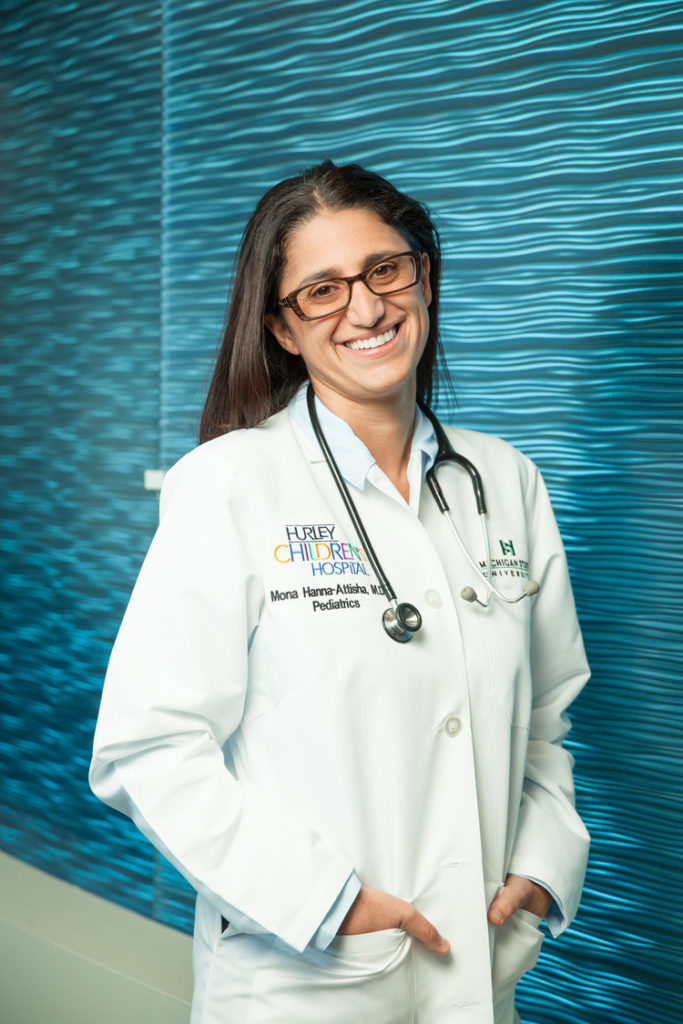Breadcrumb
Lessons from Flint
By Josh O'Leary
Published on June 27, 2019
The researcher who revealed the Flint water crisis talks about speaking up, respecting science, and moving forward.
 Flint, Michigan, was once the embodiment of the American dream. The birthplace of General Motors, the city offered the promise of living wages, good schools, accessible health care, and pension plans.
Flint, Michigan, was once the embodiment of the American dream. The birthplace of General Motors, the city offered the promise of living wages, good schools, accessible health care, and pension plans.
But by 2015, that dream had become as murky as the drinking water running from the city’s taps. That’s the year that Mona Hanna-Attisha — a pediatrician and professor at Michigan State University — released the results of a pivotal study proving Flint’s children were being exposed to dangerous amounts of lead in their water. Today, the crisis serves as a case study in governmental failure, and Hanna-Attisha — who rallied aid for Flint with her advocacy — continues her crusade to hold the powerful accountable, serve as a voice for working-class families, and lead the effort to rebuild the city’s once flourishing dream.
Hanna-Attisha visited the UI College of Public Health in March 2019, where she gave two talks and met with students. The college selected her book, What the Eyes Don’t See: A Story of Crisis, Resistance, and Hope in an American City, as its annual collegewide book club title. Hanna-Attisha recently answered a few questions about her work and how Flint is doing today.
How meaningful is it to know your book is being studied at the UI and other universities?
To be able to share this story and have others learn from it in hopes they can do similar work has been absolutely inspiring. In my head when I was writing this book, the audience was students — medical students, public health students, undergrads, and high school students — so they could take up these lessons.
The title of the book, What the Eyes Don’t See, is about the people and places and problems all over that we choose not to see. It’s about the power that we all have within us to open our eyes and to not only be awake and alert, but to act when we see things that aren’t right.
In your book you write that there are Flints everywhere. What do you mean by that?
The story of Flint is what happens when you take away democracy. Flint was an egregious example — the city had lost its democracy and was under the control of emergency management. But it’s not isolated to Flint. Throughout the country, there are people who are pre-dominantly poor and of color who are disproportionately burdened by environmental issues.
It’s the story of crumbling infrastructure and what happens when we disrespect science. It’s a “today” story in terms of the denial of climate change and the regulations that protect our air and water quality. And it’s the story of how everyday people said, “We don’t accept the status quo” and spoke up and made a difference in their community.
Do you remember the moment when the enormity of Flint’s problems hit you?
It happened really early, even before I had any of the data in my hands. In the world of lead, you’re supposed to practice something called primary prevention. The only treatment for lead is prevention. So when you hear about the possibility of lead in the environment, you shouldn’t have definitive proof that it’s in somebody’s body, because by then it’s too late. Fundamentally, it’s using children as detectors of contamination.
When I heard about lead being in the water, from that point on I knew it was serious. Unfortunately, I knew that if I was going to get anyone to pay attention to me, I needed that proof of impact. And that’s what our research showed — that yes, the children did have more lead in their blood. But it didn’t need to get to that point. This crisis should have stopped when that first mom said, “Hey, there’s something wrong with my water.”
How is Flint doing today?
We’ve made tremendous progress. Flint’s pipes are almost completely replaced, which is phenomenal. It’ll be only the third city in the country to have replaced its lead pipes. In terms of children’s issues, where I spend my day, we’ve done amazing work. We’re building a model public health program to mitigate the impact of this crisis and promote the development of children. We have things like new childcare centers, literacy support, school health services, mobile grocery stores, and Medicaid expansion. What we hope to do, and what we already are doing, is share our best practices with other cities where children are suffering from very similar toxicities.
One example is that in our clinic, we give every child a nutrition prescription. It’s an actual prescription for healthy food that they can fill at our farmers’ market. Because of the success of that program, it was included in the U.S. farm bill, so it’s become a national program. That’s one of the ways we hope to share what we’re doing to benefit kids all over.
Out of our darkest hour, Flint has set a path forward and built this model program so that we won’t be remembered for this crisis and terrible tragedy, but be remembered for our recovery.
This story appeared in the spring 2019 issue of InSight. A version of this interview originally appeared in the March 2019 issue of Iowa Magazine.
Photo (c) Mike Naddeo